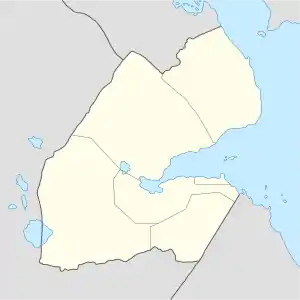Sagallo
Sagallo (Russian: Сагалло; Arabic: ساغلو; French: Sagallou) was a short-lived Russian settlement established in 1889 on the Gulf of Tadjoura in French Somaliland (modern-day Djibouti). It was located some 149 kilometres (93 miles) west of Djibouti City.
Sagallo ساغلو | |
|---|---|
 Sagallo ساغلو Location in Djibouti | |
| Coordinates: 11°40′N 42°44′E | |
| Country | |
| Region | Tadjoura Region |
| Elevation | 21 m (69 ft) |
History
Sagallo was originally a small seaside village. During antiquity Sagallo was part of the city-states that in engaged in a lucrative trade network connecting the merchants with Phoenicia, Ptolemaic Egypt, Greece, Parthian Persia, Saba, Nabataea, and the Roman Empire.
French rule
| Historical affiliations |
|---|
The Ottoman Empire had control over the area from the sixteenth to the nineteenth century. From 1862 until 1894, the land to the north of the Gulf of Tadjoura was called Obock and ruled by Somali and Afar Sultans, local authorities with whom France signed various treaties between 1883 and 1887 to gain a foothold in the region.[1][2][3] In 1894, Léonce Lagarde established a permanent French administration in the city of Djibouti and named the region Côte française des Somalis (French Somaliland), a name which continued until 1967.
Russian rule
| Historical affiliations |
|---|

In 1883, Nikolay Ivanovitch Achinov (an adventurer, and burgess of Penza[4][5] b. 1856[6]) visited Abyssinia (Ethiopian Empire) in order to establish clerical and political ties between the two countries. After his return to Russia, Achinov voiced his plans for an 1888 expedition to the Gulf of Tadjoura to establish a settlement, while claiming to be a free Cossack. Achinov assured the participants that the sultan of Tadjoura, Mohammed Loitah, had permanently leased him land in the region.[7] On 10 December 1888, Achinov along with 165 Terek Cossacks boarded Kornilov, a ship heading from Odessa to Alexandria. The expedition then boarded the Russian ship Lazarev which brought them to Port Said. There, Achinov rented the Austrian ship Amfitrida, which entered the Gulf of Tadjoura on 6 January 1889. The expedition was greeted by a group of Ethiopian priests.[7] Achinov struggled to keep the Cossacks under his control, but some raided the Danakil, stealing a cow and a sheep after driving off the local tribesmen with rifle fire. The sultan accepted 60 francs from Achimov as reparations.[8] The French foreign office demanded an explanation of Achimov's actions, and the Russian ambassador in Paris distanced the Russian Empire from Achimov. On January 14 the abandoned Egyptian fort of Sagallo was chosen as the new base of the expedition. Achinov named the fort New Moscow. A tent was erected to serve as the church of St. Nicholas and a flag of the expedition was raised.[7] Rumours about the formidable size of the expedition quickly spread through the press. Later, several colonists escaped to Obock, informing the French of the settlement's whereabouts. On 5 February, the Cossacks noticed one French cruiser and three French gunboats. An ultimatum was issued, but Achinov misunderstood it and did not surrender. The artillery barrage that followed came as a complete surprise for the Russians, leaving 6 colonists dead and 22 wounded.[9] A white shirt was raised to show surrender. The Russian Government disavowed Achinov, accusing him of disobedience to the Czar and acts of piracy. Participants were arrested and deported back to Odessa aboard Zabiyaka.[8]
Climate
| Climate data for Sagallo | |||||||||||||
|---|---|---|---|---|---|---|---|---|---|---|---|---|---|
| Month | Jan | Feb | Mar | Apr | May | Jun | Jul | Aug | Sep | Oct | Nov | Dec | Year |
| Average high °C (°F) | 29.2 (84.6) |
29.4 (84.9) |
31.4 (88.5) |
33.5 (92.3) |
36.5 (97.7) |
40.1 (104.2) |
41.8 (107.2) |
40.8 (105.4) |
38.0 (100.4) |
34.2 (93.6) |
31.5 (88.7) |
29.9 (85.8) |
34.7 (94.4) |
| Average low °C (°F) | 20.2 (68.4) |
23.2 (73.8) |
24.6 (76.3) |
26.2 (79.2) |
28.8 (83.8) |
31.7 (89.1) |
31.0 (87.8) |
30.5 (86.9) |
30.8 (87.4) |
26.5 (79.7) |
24.1 (75.4) |
21.0 (69.8) |
26.6 (79.8) |
| Average precipitation mm (inches) | 10 (0.4) |
8 (0.3) |
12 (0.5) |
13 (0.5) |
7 (0.3) |
1 (0.0) |
6 (0.2) |
20 (0.8) |
9 (0.4) |
11 (0.4) |
22 (0.9) |
15 (0.6) |
134 (5.3) |
| Source: Climate-Data.org[10] | |||||||||||||
References
- Raph Uwechue, Africa year book and who's who, (Africa Journal Ltd.: 1977), p.209.
- Hugh Chisholm (ed.), The encyclopædia britannica: a dictionary of arts, sciences, literature and general information, Volume 25, (At the University press: 1911), p.383.
- A Political Chronology of Africa, (Taylor & Francis: 2001), p. 132 ISBN 1857431162.
- Ashinov, Achinov, Atchinoff or Atchimoff
- (in French) Le cosaque Achinoff in Le Progrès Illustré (French daily newspaper), March 1, 1891
- Ernest A. Wallis Budge, A history of Ethiopia, Nubia and Abyssinia, Taylor & Francis,1928.
- "Neva,2001, №8, p. 217-220". Retrieved 15 July 2014.
- "French Somali History". Retrieved 15 July 2014.
- "Lunochkiv" (in Russian). Retrieved 16 July 2014.
- "Climate: Sagallo – Climate graph, Temperature graph, Climate table". Climate-Data.org. Retrieved 29 November 2017.
Further reading
- . Encyclopædia Britannica. 23 (11th ed.). 1911.
- Harding, Les. Dead Countries of the Nineteenth and Twentieth Centuries. The Scarecrow Press, 1998.
- Jean Robert Constantin (comte de), L'archimandrite Païsi et l'ataman Achinoff: une expédition religieuse en Abyssinie. Librairie de la Nouvelle Revue, 1891.
- French Somali Coast 1708–1946, schudak.de (without date).